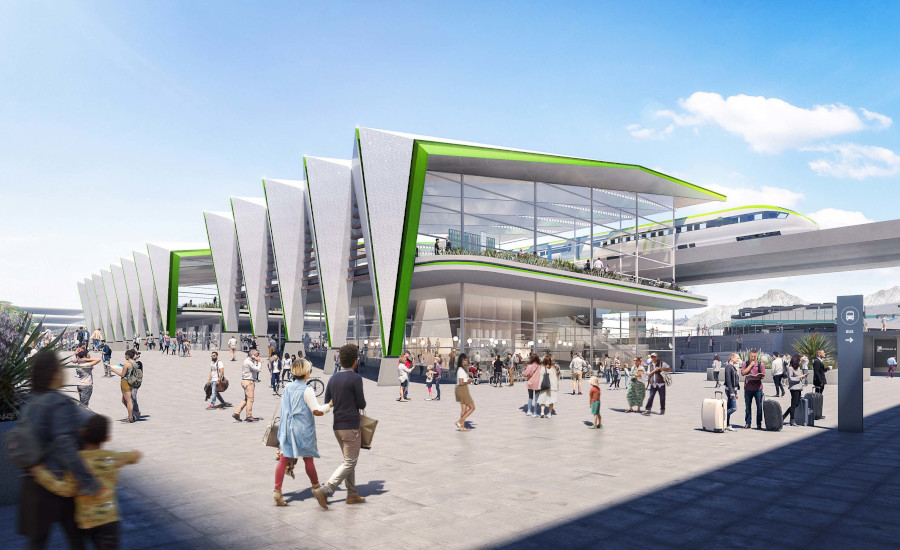Wildlife Crossings Planned for SoCal-to-Las Vegas High-Speed Rail

Brightline West’s plans for the Southern California to Las Vegas line includes a station in Rancho Cucamonga.
Rendering courtesy Brightline West.
A proposed high-speed rail line connecting Southern California and Las Vegas will include wildlife crossings as part of an agreement between the developer, Brightline West, and the California Department of Fish and Wildlife (CDFW).
The developer received approval from Caltrans two years ago to construct the rail line in the right-of-way of Interstate 15. The dedicated wildlife crossings announced this week will cross over the existing northbound and southbound highway lanes and the future high-speed rail system to be built within the median.
The crossings will help protect the Mojave Desert wildlife, notably bighorn sheep.
Construction on the rail line is expected to begin in the second half of this year and is expected to be completed within four years, says Brightline. The company says it has not yet selected a lead contractor for the project.
The three overcrossings are located in San Bernardino County near the famous Zzyzx Road as well as those near Mountain Pass and near Rasor Road. The structures are being designed and built by Brightline West, in collaboration with CDFW and Caltrans.
Brightline’s 218 mile-long, high-speed rail system is designed to connect Las Vegas and Southern California with a fully electric, emission-free system. The project includes stations in the Southern California cities of Rancho Cucamonga, Hesperia and Apple Valley, as well as Las Vegas.
The company says its all-electric train, with speeds of up to 180 mph, will keep 400,000 tons of carbon dioxide out of the air each year.
“Beyond significantly cutting carbon emissions and creating a cleaner, more efficient way to travel, this is just one more way the introduction of this system will ensure vital and long-term protections for a diverse array of wildlife,” said Sarah Watterson, president of Brightline West, in a news release.
The rail project, estimated to cost $10 billion, is currently near shovel-ready with agreements in place for station land and rights of way, says a spokesperson for Brightline.
The re-evaluation of the environmental approval for the portion of the route between Las Vegas to Victor Valley was completed in September 2020. The environmental report for the Rancho Cucamonga route was released in November 2022. The Federal Railroad Administration is expected to finalize permits next month, and the company is preparing a Fed-State Partnership grant application that will be submitted in April.
The civil and rail infrastructure portion of the project is being led by HNTB in California and Jacobs in Nevada. The high-speed rail systems design will be part of a turnkey contract with the yet-to-be selected supplier, says Brightline.
Brightline says that it has worked with Caltrans and CDFW for the past year to develop a coordinated plan to fund, design, construct and maintain the wildlife overcrossings.
The parties intend to fund the overcrossings using a mix of Caltrans, CDFW and Brightline West capital resources, while also seeking federal dollars.
“Caltrans has set aside funds to cover 75% of its internal preliminary estimate of $125 million for the capital cost of construction,” says Caltrans spokesman Will Arnold. “Once construction is complete, Caltrans will own, operate and maintain the overcrossings.”
Transportation corridors present a number of dangers to wildlife in addition to the possibility of being struck while crossing roads and railways. A recent study by the National Park Service found roads and development also created islands of habitat that can genetically isolate wildlife such as mountain lions, bighorn sheep, bobcats, birds and lizards.
Beyond the three wildlife overcrossings, Brightline West says its rail project will maintain or improve more than 600 culverts and large-scale crossings under I-15 that exist today. The project also will restore and install desert tortoise fencing and directional wildlife exclusionary fencing.
Additionally, when animals try to cross roadways they pose a danger to passing vehicles. The Federal Highway Administration estimates that there are between one and two million vehicle-animal strikes each year, causing more than $8.3 billion in related costs.
“At a basic level, these structures provide a win-win for humans and wildlife alike, measured in foregone mortality events as well as in economic terms,” says Matt Skroch, The Pew Charitable Trusts project director for U.S. public lands and rivers conservation. “By facilitating wildlife movement away from the lanes of traffic—either above or below grade—we see less human injury or death, less wildlife loss and more resilient ecosystems due to improved landscape connectivity.”
One of the largest recent examples of a wildlife crossing is the $90-million Wallis Annenberg Wildlife Crossing that Caltrans broke ground on last April. This public-private partnership, set to open in 2025, spans 10 lanes across the busy 101 Freeway in Western Los Angeles County and is 210 feet-long.
This article was originally written by Greg Aragon and appeared here.


Comment (0)